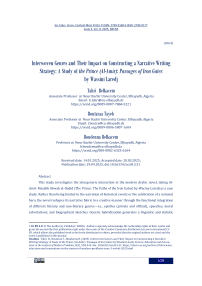Interwoven Genres and Their Impact on Constructing a Narrative Writing Strategy: A Study of the Prince (Al-Amir): Passages of Iron Gates by Wassini Laredj
Автор: Tahri B., Boutaraa T., Boudenna B.
Журнал: Science, Education and Innovations in the Context of Modern Problems @imcra
Статья в выпуске: 3 vol.8, 2025 года.
Бесплатный доступ
This study investigates the intergeneric interaction in the modern Arabic novel, taking Al-Amir: Masalik Abwab al-Hadid (The Prince: The Paths of the Iron Gates) by Waciny Laredj as a case study. Rather than being limited to the narration of historical events or the celebration of a national hero, the novel reshapes its narrative fabric in a creative manner through the functional integration of different literary and non-literary genres—i.e., epistles (private and official), speeches, moral exhortations, and biographical sketches. Generic hybridization generates a linguistic and stylistic mosaic that enriches the novel's artistic form and broadens its ideological horizon. The paper dis-cusses the ways in which these intertangled genres are employed as a means of fostering linguistic diversity and serving the novel's general narratorial strategy—first and foremost, the East-West civilizational dialogue that forms the thematic core of the text. Prominent in the discussion is the role of the epistolary genre as a non-confrontational medium of communication enabling the narra-tor to avoid overt ideological polarization and offer subtle reconciliatory discourse. Where do speeches and moral teachings have rhetorical and persuasive, the biographical element gives his-torical texture and emotional weight. The findings indicate that the embedded genres are neither ornamental nor superficial but structurally essential. They play a dynamic role in narratorial guid-ance, in enriching the polyphonic voice of the narrative, and in allowing the novel to navigate diffi-cult historical and cultural terrain. This approach emphasizes how the contemporary Arabic novel transcends rigid genre divisions and embraces literary hybridity as a strategy of aesthetic enrich-ment and critical intervention. Ultimately, the book demonstrates that genre interpenetration is not an optional stylistic choice, but a narrative strategy that enriches the novel's capacity for nuanced discourses on identity, memory, and intercultural dialogue. The result is a work that not only enter-tains and informs but also redefines the boundaries of narrative in Arabic fiction.
Genre Hybridization, Linguistic Diversity, Narrative Strategy, Epistolary Form
Короткий адрес: https://sciup.org/16010507
IDR: 16010507 | DOI: 10.56334/sei/8.3.31


